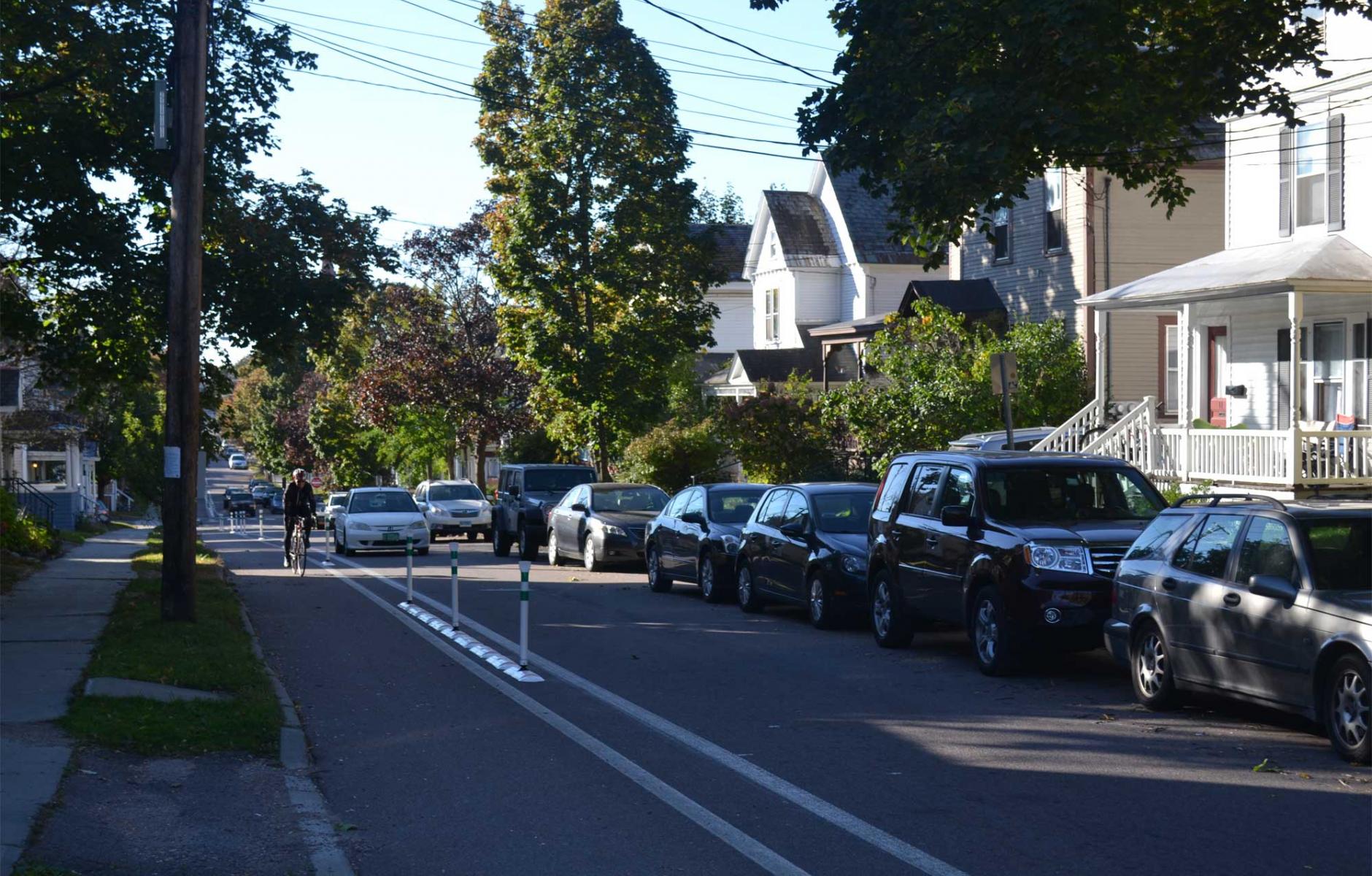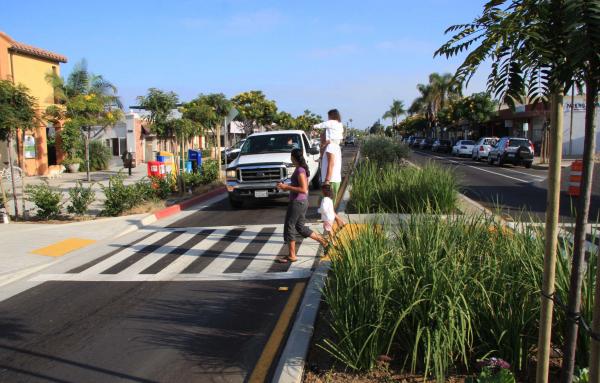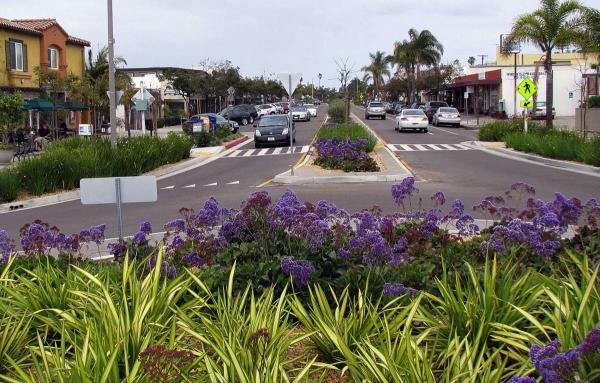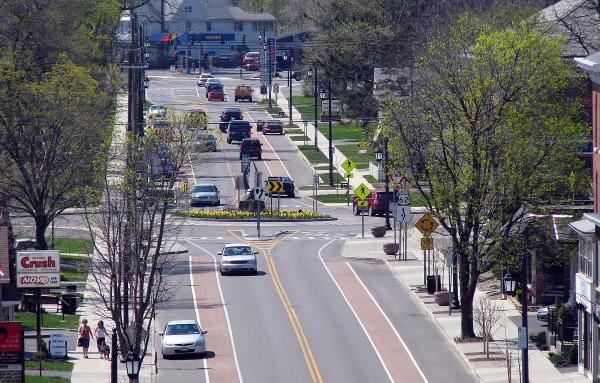
Merging Tactical Urbanism with public works
Burlington’s interest in bike-walk issues goes back decades, at least to when Bernie Sanders was mayor, when his administration focused on the revitalization of downtown and the waterfront in the 1980s—working with Republicans and Democrats at the start of his political career. The city of 42,000 on Lake Champlain, home to the University of Vermont, has long employed a 30-day pilot program to test public works projects. This program was used in closing the first block to traffic for what is now the Church Street Marketplace.
It makes sense that when Burlington adopted its first ever Bike-Walk Plan in 2017, implementation would go hand-in-hand with Tactical Urbanism. With the motto “short term action for long term change,” Tactical Urbanism is all about testing changes to the public realm to improve the experience of pedestrians and cyclists—often using less expensive, flexible materials.
Burlington is now refining a tactical approach to bike-walk streetscape alterations that cost about a quarter of a full-scale street rebuilding—and can be implemented much faster. “We felt this was the logical next step,” says Nicole Losch, a senior planner with the Department of Public Works.
In a year and a half since the plan was adopted, Burlington has built a Neighborhood Greenway in the Old North End neighborhood to provide a slow-speed cycling route stretching more than a mile from the university campus to a lakefront park. The greenway slows down traffic through curb extensions and mid-block pinch points, using materials that are easy to move and adjust. The city has also made improvements on a five-way intersection in the city’s South End, installed a protected bike lane on Church Street near two schools, and installed curb extensions and other changes to intersections in downtown locations.
The usual streetscape change involves a lengthy process of planning, engineering drawings, funding, paving, and construction—and then you find out how well it works. This can take years and consequently few projects are implemented. Burlington has replaced that method with a four-step incremental process. A week-long tactical demonstration project can be initiated by citizens. The 30-day pilot project can be initiated by Public Works. The next step up from that is a Quick Build project, designed to last for one to five years. Permanent street changes involving new pavement are the final step—after a project has been adjusted and tested to work out the kinks. Most of the changes in the last year and a half have been completed through the Quick Build program, which involves materials that can be tested and moved—and even removed seasonally if difficulties arise in Burlington’s long winters. The city has adopted its own Quick Build Design + Materials guide that systemizes the approach. “I definitely recommend that other cities try something that is similar,” says Losch.
Burlington hired Street Plans Collaborative to do the Bike Walk comprehensive plan. Principals Mike Lydon and Anthony Garcia are known as Tactical Urbanism thought leaders—they have written a book and numerous other publications on the subject. The collaboration led to the city adopting the community demonstration project approach, giving residents a way to implement short-term streetscape projects. The city can only complete so many projects a year. If the city can’t get to a project that neighbors want, the residents can apply for a demonstration and build it themselves. “If successful, it will be a priority the next year,” says Losch.
The flexible Quick Build program is another innovation. “We wanted it to be a one-stop shop, outlining the materials that could be used, navigating the permit process and working with neighbors,” says Losch.

The North End greenway meanders east-west along mostly low-volume neighborhoods streets. The city is still formally gathering data on its success. “Anecdotally, we’ve heard it is working,” she says. “It is a better route than they would have expected and really convenient, especially by bike.” No changes were made to pavement, which accounts for the low cost and flexibility. Curb extensions that narrow the street and reduce crossing distances are marked by paint, large planters, and “low, flexible bollards” that can be shifted in their position. During winter when Burlington gets a lot of snow, the plantings are removed and then replaced the next spring.
How is it working for public works employees, who are responsible for snow removal and maintenance? “We are fortunately to have a pretty open-minded team that recognizes that the city is growing differently,” says Losch. “The projects benefit the community, although they are not making the Public Works jobs easier. We are training the drivers to anticipate the changes before the snow flies, and working with the planners and the street maintenance team on the projects.”
An additional advantage to the Quick Build program comes in Burlington’s long winters. There’s the option of removing part or all of a project and re-installing in the spring. The city is considering a seasonal option for a protected bike lane due to winter challenges and lower seasonal use. That option is only possible because of the flexible material pallet of Quick Build.
The City of Burlington has used the Quick Build Design + Materials Standards to install five pedestrian, bicycle, and public space projects, most notably the 1.25-mile Greenway, connecting the campus to the waterfront. The Old North End Greenway is an interim design that can be adjusted easily depending on observed function and utility. There is no change to the street section, new pavement, or permanent plantings—yet the project has resulted in a dramatic change to the streetscape.







